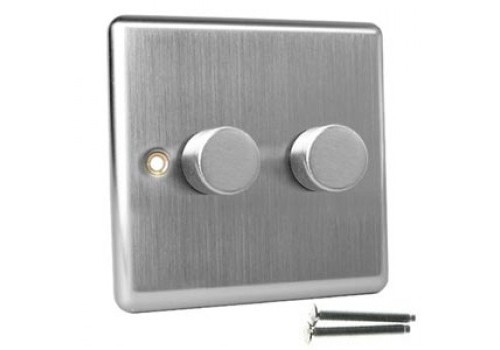
Lighting has become so much more efficient in the last few decades. We have moved from old fashioned incandescent bulbs to CFL and LED bulbs, which can save up to 90% on your lighting costs, but people know less about their dimmer switches. How do they work, and do they actually save you money?
What is a dimmer switch?
Dimmer switches allow you to alter the amount of light produced from a lightbulb, without the need for installing complex wiring. They mean you can produce mood lighting, which can have a dramatic impact on the look and feel of a room. Different lighting can create a completely different atmosphere without the need to move any furniture around a room or redecorating and all this can be achieved with a simple dimmer switch.
Does a dimmer cut your energy use?
Dimmers have been around for a very long time, almost as long as the light bulb itself. In the early years, they worked by adding resistance to the circuit, which turned the energy into heat rather than light. This does not reduce the amount of electricity being used, it just changes the amount being turned into light. This has the added problem of the excess heat, which could potentially be quite dangerous!
Modern dimmers don’t work that way. There are several different variations, but effectively modern dimmer switches cut the supply on and off rapidly at hundreds of times per second – something called a TRIAC switch. This reduces the amount of power reaching the bulb, reducing the brightness. This does reduce the overall amount of power being used and therefore you could call them more efficient.






Better to dim or not to dim?
With LED lights the effect of dimming compared to power use is fairly linear. However, dimming incandescent is actually less efficient than using a lower wattage of bulb. For example, a 60W bulb dimmed to the brightness of a 40W bulb will use more energy than a 40W bulb on maximum. The light will also tend to be ‘warmer’ in colour.
What are the benefits of dimming?
Using a dimmer can actually help prolong the life of your bulbs. This is because bulbs running at lower power get put under less stress as there is less heat being emitted.This is why some of those famous bulbs you see on the internet that are still running after 100 years tend to be at very low levels – they would have burnt out long ago if they were at maximum output.
>>> Choosing the right LED lighting <<<
Dimming is really useful because it lets you alter the light levels subtly, rather than just having ‘on’ and ‘off’. It really adds another dimension to your home’s lighting. So don’t be afraid to get dimmers for your home. They won’t be wasting you energy – in fact they should save you a little and prolong the life of your bulbs.
Think we missed something? Do you have a different opinion?
Comment below to get your voice heard…













But dimmmable LED costs more. Also non-dimable LED and a dimmer can damage the circuit inside quicker than full power consumes the led.
Depends where you shop. Led bulbs do cost a little extra, but not by much these days. And paying the extra saves electric and prolongs it’s life, so buying a dimmable led is worth it over its lifetime compared to standard led bulbs. 2 of my lights are smart led bulbs. Expensive, but so good to literally have remote controlled main lights I can operate from anywhere and set their brightness
But incandescent bulbs are less efficient at lower filliment temperatures. Halogen bulbs are more efficient because they operate at higher filliment temperatures. Actually non dimmable LED’s use basic switching power supplies that keep light output constant sa voltage drops untill it reaces a limit after which they may not work at all, or may flash rapidly like a strobe light.
Not for long. Soon all LED bulbs will be dimmable with a negligible, if any increase in cost.
Good article, but I have to point out an inacuraccy. The older dimmer switches are not as efficient in energy savings as newer ones, but by the very nature of Ohm’s law they do conserve. Some of the energy is converted to heat – that much is correct.
Ohm’s Law states that the current through a conductor between two points is directly proportional to the potential difference across the two points. Introducing the constant of proportionality, the resistance, one arrives at the usual mathematical equation that describes this relationship:
I=E/R. where I is current (amperage), E is voltage and R is resistance.
If you increase resistance, you reduce voltage and current. Some losses are present in the form of heat or electrical leakage due to inefficiency of components, but there is still a reduction.
But incandescent bulbs are less efficient at lower filliment temperatures. Halogen bulbs are more efficient because they operate at higher filliment temperatures.
Dave,
You are on the right track and mostly correct. Voltage is a constant however. Assume you have 100V coming into your house and a 100W bulb. If you reverse engineer it, that 100W bulb has a resistance of 100 Ohms. Total current is 1A. If you add an old school dimmer in series with the bulb, that would result in added resistance. If that dimmer is set to 100 Ohms, you now have a total resistance of 200 Ohms with a 100V source. Using Ohms law V*V/R you get 10,000/200 =50watts.(a total savings of 50%)
It’s been over 25 years since I got my degree in EE, so I could be off on this one, but I think it’s right
.
Just one thing that is unclear for me then. I would actually agree with the article. Of course the dimmer will lower the voltage on the output but for the cost that the rest of the volts are lost on the resistance. And at this point there are watts (heat) on the resistor since P=I*E. All together the old dimmers were working exactly how the article says. They did not help in savings.
I think the simplest way to put it into layman terms would be:
ρ(T ) = A (T/ΘR) n ΘR/T f 0r/t n (et − 1)(1 − e−t) dt.
It’s obvious really..
In layman’s terms?
The formulae does not contain I or E, R seems to be there.
Further, you need to know what these symbols mean as well as Integration / differentiation that a layman has not idea about.
I may as simple as 123 for a professor in math but certainly your explanation is totally useless for a layman.
Just my 2 cents.
.
You’re a dickhead
lol … Bc
the time at which the triac is switched on in each cycle of the ac waveform determines the power that is delivered to the incandescent lamp. Read up on how a tric controller works and how the power is saved
Exactly what I would have said.
Thank you for the answer!
This article is full of errors, check your facts
Can we have straight bog standard answer as to whether you can save money by using a dimmer or not, I have a room with 12 led low what GU 10’s in them 3watts each they are very bright.
I want to dim will it save money YES OR NO ?
Hi Anthony! The bottom line is that yes, it will save money, but the amount will be negligible. Hope that helps!
I’ve long used dimmers on halogen lighting as well as regular incandescents on lighting my dining rooms in the (over 30 years) restaurant. I’ve enjoyed the benefits of long life ( as much as 5 times rated life ) and saves time in maintenance and cost to replace. Where I needed about 60 watts of lighting I would purchase 100 watt long life bulbs and many times over a twenty year periods there would be bulbs I never had to replace, especially the halogen bulbs. But there would be “duds” that wouldn’t hold up. I do ponder whether led or CFL’s have the same long life because of the complex circuitry they have inside. Also I do see CFLs and even leds that burn out prematurely. Certainly not the long life they claim nor the same results of dimming I had with halogens and incandescents in the past. I would also like to note that cities use dimmed bulbs for traffic lighting using 130 volt bulbs rather than 120 volt and getting better life. This is my two cents. Thank you. I no long manage the restaurant.
STATEMENT 1
modern dimmer switches cut the supply on and off rapidly at hundreds of times per second – something called a TRIAC switch. This reduces the amount of power reaching the bulb, reducing the brightness. This does reduce the overall amount of power being used and therefore you could call them more efficient.
STATEMENT 2
” dimming incandescent is actually less efficient than using a lower wattage of bulb. For example, a 60W bulb dimmed to the brightness of a 40W bulb will use more energy than a 40W bulb on maximum.”
Im confused w the 2 statements. IS author contradicting himself??? Is dimmer more efficient or not????
Hi Django,
No, the author is not contradicting himself, you are just a little confused here. If a 60 watt bulb was dimmed to the equivalent brightness of a 40 watt it would use less electricity (making it more efficient that a 60 watt), however, it may actually consume 48 watts. Therefore, dimming the bulb improves the efficiency of the lighting when you don’t want the light at full brightness, however, dimming is not as efficient as simply buying a bulb at specific suggested watt rating.
And don’t throw that CFL or LED bulb in the trash like an old virtually harmless incanescent. CFL’s and LED’ are toxic waste,.but do you think all users of new bulbs properly dispose of them? Nope. Millions of bulbs need to be discarded each year. How many get proper recycle? We are saving the world energy, but filling the ground and water with toxins. Fix one hole in the dam while another on gets bigger.
JT, you’re such a Republican.
You can’t use dimmers with led or other energy saving bulbs because the bulbs burn out after a few weeks or less.It says so on the package.
Hi George,
That’s why it’s important to buy the specially marked dimmer bulbs!
Thanks,
Harri
The whole point of dimming switch is to create atmosphere when you need it. Why do tech heads never incorporate any aesthetic reasoning? A 60w bulb dimmed to 40w Creates a nicer environment for relaxing and saves energy. The idea that a 40w bulb is a better energy saver misses the fact that I’ll be wasting lots of energy getting a ladder out to change the bulb back to 60w every time I need a brighter room. On top of all this the older bulbs create a nicer light so I will never move to LED until manufactures take the horrible green tinge from the light it makes. Good old fashioned tungsten and halogen are by far the best to be dimmed and in the long run you’re only spending a few quid more to have beautiful lighting throughout winter. Some people I notice still sit in rooms with fluorescent strips! Terrible lighting.
I hope making a LED dimmable will not cancel the environmental benefit of the occasional dimming?
how can we change 60w bulb to 40w bulb with regulator
This does not reduce the amount of electricity being used, it just changes the amount being turned into light. This has the added problem of the excess heat, which could potentially be quite dangerous!
Using a dimmer can actually help prolong the life of your bulbs. This is because bulbs running at lower power get put under less stress as there is less heat being emitted.
Confusing and conflicting unless I missed something?
Old style incandescent dimming ,`if some of the energy is being turned into heat it must from a logical point be off setting ones building heating all be it a small amount so are not quite as inneficient as is made out to be I rest my Case !!!
Hi Martin,
It depends if you are talking LED lights or incandescent / Halogen bulbs.
I have installed LED smart light bulbs throughout the house replacing all the existing LED I had been using. All of the LED smart bulbs are dimmable through Google Home App and Home Display etc. I can also any on the lights remotely…even save myself getting out of bed to switch off the bedroom light.
I can only assume that having them dimmed will be saving some electricity in the long term.